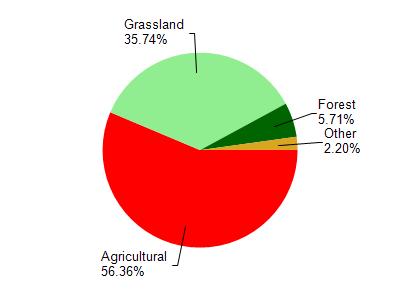Lafayette
No
No
No
Fish and Aquatic Life
Overview
This small creek is a tributary to the Cottage Inn Branch has it origin near First Capital State Park. It has not been monitored recently.
Date 2002
Author Aquatic Biologist
Historical Description
Whiteside Branch, T3N, R2E, Sections 5-5, Surface acres = 3.0, Miles = 1.7, Gradient = 35.3 feet per mile,
Total alkalinity = 285 mg/l, Volume of flow = 1.0 cfs.
Whiteside Branch is a warm water drainage stream which is a principal tributary to the Cottage Inn Branch. It has one feeder whose volume of flow is about 40 percent of its total discharge and enters about one-half mile above the mouth. Bank erosion is severe throughout most of its length due to heavy flooding. Gravel is the common bottom type while silt is found near the mouth. Firm pasture and crops make up the predominant vegetative cover of the basin. Forage fishes are the principal fishery. Game species in the watershed include pheasants, deer, rabbits and squirrels on the uplands and some muskrats on the lowlands. There are no public lands in the watershed and access is from one town road crossing.
From: Piening, Ronald; Poff, Ronald; Threinen, C.W., 1967. Lake and Stream Classification Project. Surface Water Resources of Lafayette County, Wisconsin Department of Natural Resources, Madison, WI.
Date 1967
Author Surface Water Inventory Of Wisconsin
Condition
Wisconsin has over 84,000 miles of streams, 15,000 lakes and milllions of acres of wetlands. Assessing the condition of this vast amount of water is challenging. The state's water monitoring program uses a media-based, cross-program approach to analyze water condition. An updated monitoring strategy (2015-2020) is now available. Compliance with Clean Water Act fishable, swimmable standards are located in the Executive Summary of Water Condition in 2018. See also the 'monitoring and projects' tab.
Management Goals
Wisconsin's Water Quality Standards provide qualitative and quantitative goals for waters that are protective of Fishable, Swimmable conditions [Learn more]. Waters that do not meet water quality standards are considered impaired and restoration actions are planned and carried out until the water is once again fishable and swimmable
Management goals can include creation or implementation of a Total Maximum Daily Load analysis, a Nine Key Element Plan, or other restoration work, education and outreach and more. If specific recommendations exist for this water, they will be displayed below online.
Monitoring
Monitoring the condition of a river, stream, or lake includes gathering physical, chemical, biological, and habitat data. Comprehensive studies often gather all these parameters in great detail, while lighter assessment events will involve sampling physical, chemical and biological data such as macroinvertebrates. Aquatic macroinvertebrates and fish communities integrate watershed or catchment condition, providing great insight into overall ecosystem health. Chemical and habitat parameters tell researchers more about human induced problems including contaminated runoff, point source dischargers, or habitat issues that foster or limit the potential of aquatic communities to thrive in a given area. Wisconsin's Water Monitoring Strategy was recenty updated.
Grants and Management Projects
| Project Name (Click for Details) | Year Started |
|---|
|
|
Monitoring Projects
| WBIC | Official Waterbody Name | Station ID | Station Name | Earliest Fieldwork Date | Latest Fieldwork Date | View Station | View Data |
|---|
|
|

Watershed Characteristics
Whiteside Br is located in the Middle Pecatonica River watershed which is 186.42 mi². Land use in the watershed is primarily agricultural (56.30%), grassland (35.70%) and a mix of forest (5.70%) and other uses (2.20%). This watershed has 484.82 stream miles, 27.78 lake acres and 298.28 wetland acres.
Nonpoint Source Characteristics
This watershed is ranked Not Ranked for runoff impacts on streams, Not Ranked for runoff impacts on lakes and High for runoff impacts on groundwater and therefore has an overall rank of High. This value can be used in ranking the watershed or individual waterbodies for grant funding under state and county programs.However, all waters are affected by diffuse pollutant sources regardless of initial water quality. Applications for specific runoff projects under state or county grant programs may be pursued. For more information, go to surface water program grants.